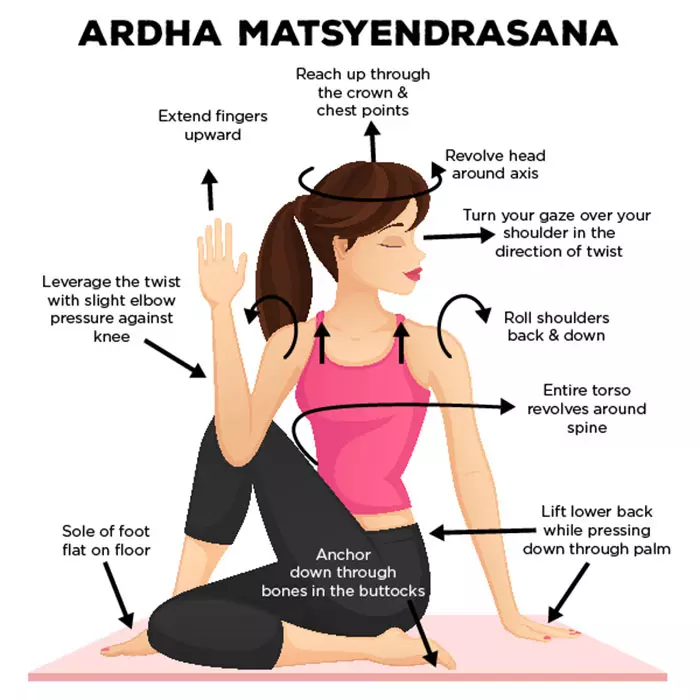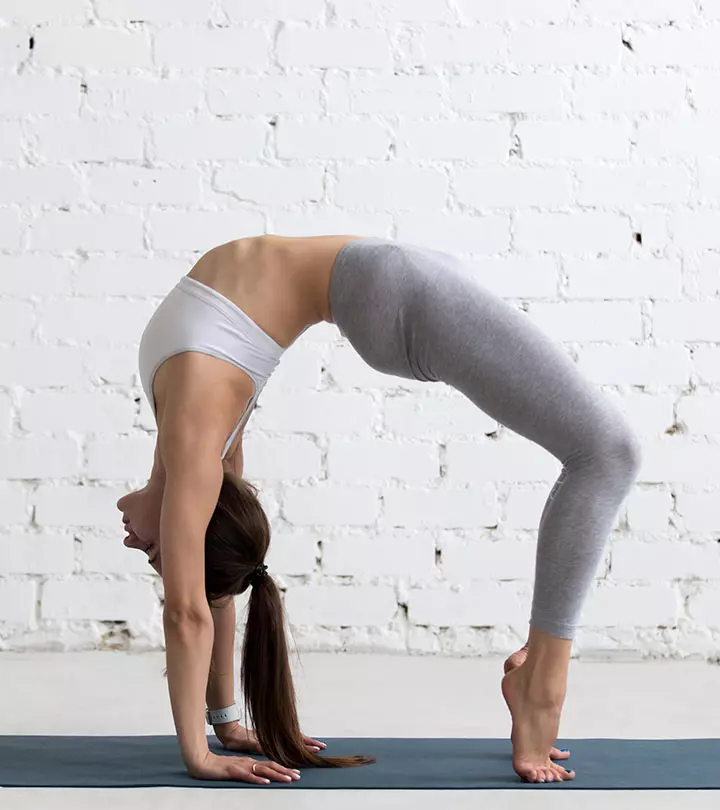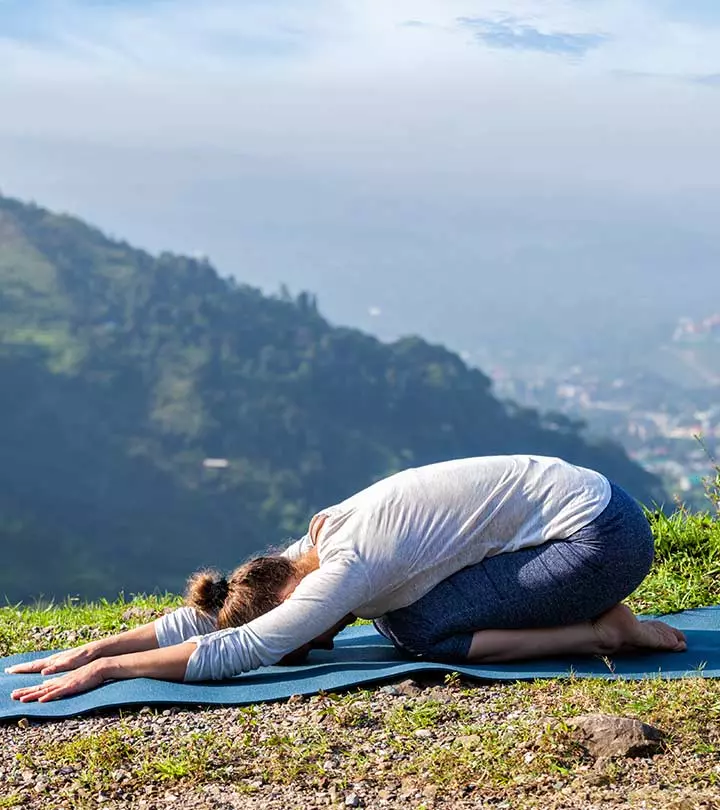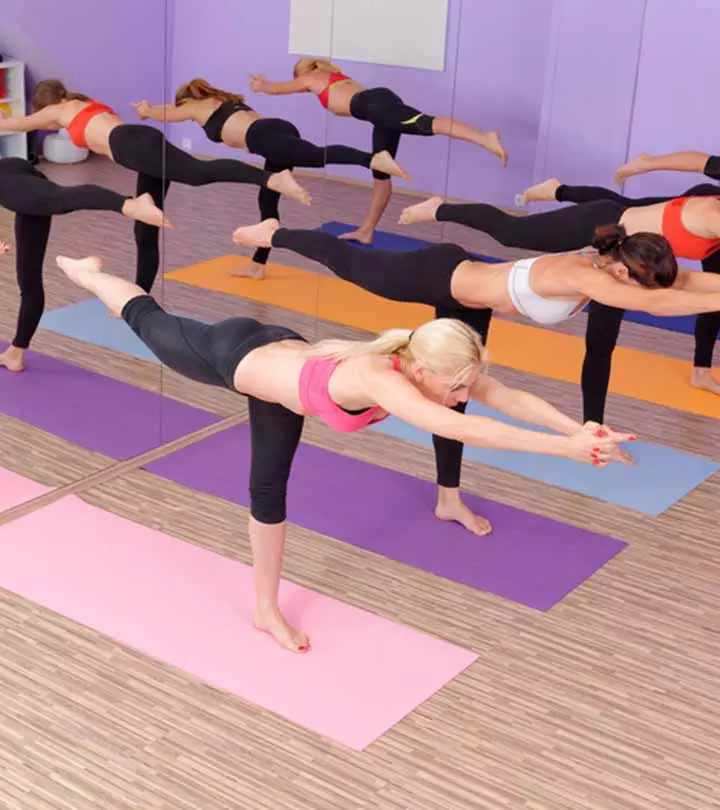How To Do The Ardha Matsyendrasana And What Are Its Benefits
The half spinal twist can make your spine more flexible and relieve muscle stiffness.

Image: ShutterStock
According to Hindu mythology, practicing Ardha Matsyendrasana during yoga and incorporating mindfulness and meditation can bring balance to the body’s energy levels and also helps in detoxification.
Ardha Matsyendrasana, Half Lord of the Fishes Pose, Half Spinal Twist Pose or Vakrasana is an asana. Sanskrit: अर्धमत्स्येन्द्रासन; Ardha – Half, Matsyendra – King of the fish, Asana – Pose; Pronounced As: ARE-dah MAT-see-en-DRAHS-anna
The yogi Matsyendranath is honored with the name of this asana. The name Ardha Matsyendrasana is derived from the Sanskrit words “ardha” (half), “matsya” (fish), “Indra” (king), and “asana” (posture). Vakrasana is another name for this asana. In Sanskrit, ‘Vakra’ signifies twisted. Half Lord of the Fishes Pose, and Half Spinal Twist are two more names for this asana. It is a sitting spinal twist that may be done in various ways. This is one of the twelve basic asanas taught in Hatha Yoga classes. Continue reading to know more.
 Trivia
TriviaIn This Article
Everything You Need To Know About The Ardha Matsyendrasana
What You Should Know Before You Do This Asana
This asana must be practiced either first thing in the morning or at least four to six hours after a meal.
Your stomach and bowels must be empty when you practice this asana. The food must be digested so that there is enough energy to expend during the practice.

- Level: Basic
- Style: Hatha Yoga
- Duration: 30 To 60 Seconds
- Repetition: Do it on the right side first and then on the left
- Stretches: Hips, Shoulders, Neck
- Strengthens: Spine, Digestive System, Urinary System, Reproductive System
How To Do Ardha Matsyendrasana
- Sit erect with your legs stretched out. Make sure that your feet are placed together and your spine is absolutely erect.
- Now, bend your left leg such that the heel of the left foot lies next to the right hip. You could also keep the left leg stretched out if you like.
- Then, place the right leg next to the left knee by taking it over the knee.
- Twist your waist, neck, and shoulders towards the right, and set your gaze over your right shoulder. Make sure your spine is erect.
- There are many ways you can place your arms to increase and decrease the stretch. But to do it simply, you can place the right hand behind you, and the left hand on the right knee.
- Hold the pose for a few seconds, about 30 to 60 as you breathe slowly, yet deeply.
- Exhale and release the right hand, and then the waist, chest, and finally the neck. Relax as you sit straight.
- Repeat the steps on the other side, and then exhale and come back to the front.
Prashant, a vlogger, shared step-by-step guidance on practicing ardha matsyendrasana, a seated twisting yoga pose. He emphasized the importance of a straight spine and flexible hips to prepare the body for the pose. While putting his one leg across the other leg, he noted, “When I drop the buttock, I’m not rounding my back. Can you see that I’m still maintaining the extension of my spine, and at the same time, I’m descending my right buttock down like this (i).”
Precautions And Contraindications
Now that you know how to do the seated half spinal twist pose, let’s have a look at few points of caution you must keep in mind while you do this asana.
- This asana must be avoided during pregnancy and menstruation as it entails a strong twist at the abdomen.
- Avoid this asana if you have a back, neck, or hip injury, or if you are in severe pain.
- People who have recently undergone abdominal, heart or brain surgeries, should not practice this asana.
- Those with a hernia or peptic ulcers must do this asana carefully and under the supervision of a certified yoga instructor.
- People who have significant spinal disorders, such as advanced scoliosis or severe degenerative disc disease, must avoid this asana. However, people who have a minor slipped disc problem will benefit from this asana. But they must do it under supervision and with a doctor’s approval.
- Before attempting this pose, anyone with inflammatory diseases of the spine or joints should exercise caution and speak with a healthcare provider.
Beginner’s Tips
The many hand variations in this pose can make it quite hard for beginners to adapt. First of all, make sure you sit on a blanket and practice this yoga twist pose. Next, before you try the hand and arm variations, just wrap one arm around the raised leg, and hug your thigh to your torso. With practice, you can start trying other variations.
Advanced Pose Variations

This is an advanced pose you can try to deepen the stretch.
- If your hips and spine are flexible enough, you can bring the upper left arm to the outside of the upper right thigh.
- Keeping your legs placed the way they should be, exhale and turn your gaze to the right.
- Lean away from the upper thigh, and bend the left elbow such that it presses against the outside of the upper right thigh.
- Now, cuddle your torso against your thigh, and work the upper left arm on the outer leg until the back of the shoulder presses against the knee.
- Let your elbow stay bent, and hand raised towards the ceiling. Lean in to form a slight upper back bend. Your shoulder blades must be firm against the back. Make sure you lift the front of your torso through the top sternum.
Benefits Of The Half Spinal Twist

These are some amazing benefits of the Ardha Matsyendrasana.
- This asana makes the spine more flexible. It tones the spinal nerves and improves the way the spinal cord functions.
- This asana helps to stretch the muscles on one side of the body while compressing the muscles on the other side.
- This asana helps relieve stiffness and back pain from between the vertebrae.
- This asana helps to cure a slipped disc.
- Getting into a twist massages the abdominal organs, therefore increasing the digestive juices and increasing the functioning of the digestive system.
- This asana helps to massage and stimulate the pancreas, and thus, helps those suffering from diabetes.
- This asana helps to regulate the secretion of both adrenalin and bile.
- The asana helps to relieve stress and tension that is trapped in the back.
- It also helps to open up the chest and increase the supply of oxygen to the lungs.
- It helps to loosen the joints at the hip and also releases stiffness.
- It increases the circulation of blood, purifies the blood, and detoxifies the internal organs.
- This asana increases the circulation of blood to the pelvic area, thus providing nutrients, blood, and oxygen, and improving the health of the reproductive system as well as the urinary system.
- This asana also helps to cure urinary tract infections.
- This asana is also beneficial for menstrual disorders.
- This asana is beneficial for mental health in general since it can improve mental clarity and lower anxiety.
 Trivia
TriviaThe Science Behind The Vakrasana
After a tough, challenging workout, a twist like the Ardha Matsyendrasana can be extremely relaxing. But this pose is also fortifying and has a whole lot of amazing benefits. So don’t let yourself get too complacent as you do this asana. According to the 2017 National Health Interview Survey, yoga was the most common complementary health and wellness practice among Americans, with an adoption rate of 14.3% that year. Women (19.8%) were more likely than men (8.6%) to engage in yoga within the past 12 months. Yoga was more than twice as common among adults aged 18-44 (17.9%) compared to those aged 65 and over (6.7%). Getting into the pose is easy, but the real goodness is in the action of twisting. When you contract your torso muscles and elongate and rotate your spine while deepening your breath, you are greatly benefitted.
Be conscious and work towards gaining the benefits of Ardha Matsyendrasana step by step. This asana will help you stretch your outer hips and thighs. It also opens up the front of your shoulders and chest as it builds strength along the sides of your body. The twisting pose will keep your spine healthy as it squeezes and rehydrates the spongy discs that lie between the vertebrae. These tend to get compressed as you age.
Try to avoid slouching and slumping during this asana – it will limit the degree of spinal rotation that you are capable of. For a deep twist, you must lengthen your spine and make enough space between your vertebrae. Use your breath to deepen the stretches. Inhale and lengthen yourself, and exhale and twist deeper.
If this asana is practiced with dedication, this deep-seated twist can confront reality and let you know what is really going on in your hips, spine, and even your mind. The seated posture lets you take account of a bloated stomach, and also if your breath is constricted or muscles are stiff.
Preparatory Poses

Baddha Koṇāsana
Janusirsasanai A head-to-knee pose that stretches the entire body from the ankles to hips along with the back.
Virasanai A kneeling asana that stretches the thighs, knees, and ankles to improve digestive health and functioning.
Bharadvaja’s Twist
Supta Padangusthasana
Follow-Up Poses

Paschimottanasana
Janusirsasana
Getting your body into a deep twist such as this asana is not only beneficial but also relaxing. Once you release the twist, you will know what you feel mentally, physically, and emotionally.
While the Ardha Matsyendrasana is easy to perform, it may be challenging for people with limited flexibility. Here are some modifications you can try in such a case.
Key Takeaways
- Ardha Matsyendrasana is a seated spinal twist yoga pose that may improve spinal mobility and flexibility.
- It may tone the abdominal muscles, and stimulate digestion and metabolism.
- It may help to lower anxiety and reduce stiffness in the neck, and shoulder muscles.
- This asana may help to improve blood circulation, detoxify and help manage diabetes.
- This asana should be either performed first thing in the morning or 6 hours after eating.
Ardha Matsyendrasana Modifications
Chair Ardha Matsyendrasana

This modification is perfect for those who cannot sit on the floor due to physical limitations.
- Sit on a chair with your feet flat on the ground.
- Twist your torso to the left and hold the back of the chair with your right hand.
- Extend your left arm and hold the pose for 30-60 seconds.
- Repeat on the other side.
Extended Ardha Matsyendrasana

This modification is perfect for those who have limited flexibility.
- Sit with your legs extended in front of you.
- Bend your right knee and place the sole of your right foot against the opposite side of your extended left leg.
- Place your right arm back for support and twist your torso toward your right and your left arm extended out and down.
- Hold for 30-60 seconds.
- Repeat on the other side.
Infographic: 7 Main Benefits Of Ardha Matsyendrasana
The Ardha Matsyendrasana is an excellent natural remedy for spinal injuries and back and joint pains. Practicing it regularly can help cure various body conditions related to the digestive, urinary, and reproductive systems. Check out the infographic below to know this asana’s primary health benefits.
Some thing wrong with infographic shortcode. please verify shortcode syntax
One of the twelve asanas offered in Hatha Yogai A branch of yoga poses that focus on preserving the inner energy or force through certain physical and breathing techniques. courses is Ardha Matsyendrasana. This asana helps extend your hips and thighs on the outside. It also strengthens your body’s sides while opening the front of your shoulders and chest. In addition, it rehydrates and squeezes the spongy discs that lay between the vertebrae, this twisting yoga pose will also help maintain a healthy spine. This asana should be done either first thing in the morning or six hours after eating. Also, it must be done with an empty stomach and bowels.
Frequently Asked Questions
What is the difference between Matsyendrasana and Ardha Matsyendrasana?
Poorna Matsyendrasana is the full spinal twist, and the back foot rests on the thigh, like padmasana. In Ardha-Matsyendrasana, the back foot rests on the floor.
How many times should I do Ardha Matsyendrasana?
Ardha Matsyendrasana can be done daily. Do three reps, holding each briefly.
What are some common breathing techniques used in Ardha Matsyendrasana, and how do they enhance the benefits of the pose?
Hold the position and take gentle but long breaths. As you come back to the starting position, breathe out and relax. This improves the quality of your breathing.
Learn how to do Ardha Matsyendrasana with this easy-to-follow video. Check it out and master this sitting half spinal twist to improve your flexibility, reduce stress, and boost your general well-being.
Personal Experience: Source
StyleCraze's articles are interwoven with authentic personal narratives that provide depth and resonance to our content. Below are the sources of the personal accounts referenced in this article.
i. Correct today your ardha matsyendrasana | half spinal twist | sitting twist |https://www.youtube.com/watch?v=W4rTLSu3Qo0Read full bio of Garima Singh
Read full bio of Shirin Mehdi
Read full bio of Arshiya Syeda
Read full bio of Moksha Gandhi


























Community Experiences
Join the conversation and become a part of our empowering community! Share your stories, experiences, and insights to connect with other beauty, lifestyle, and health enthusiasts.